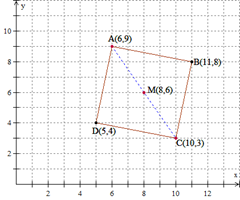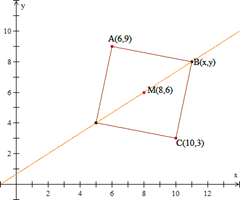If and
are the coordinates of two opposite vertices of a square, what are the coordinates of the other two vertices?
Source: NCTM Mathematics Teacher, October 2006
Solution

Let and
be the two given opposite vertices of the square. The midpoint
of both diagonals
and
has coordinates
Slope of diagonal
Slope of diagonal because the diagonals are perpendicular to each other.
By definition of a slope of we move from
to vertex
by going left
up
. Similarly, by definition of a slope of
we can count our way from
to vertex
by going right
up
. Thus, the coordinates of vertex
are
We find the coordinates of vertex the same way by going left
down
from
. The coordinates of vertex
are
Answer: and
Alternative solution

Let be a vertex of the square. The point-slope form equation of segment
is
Length of segment
Substitute the value of from Eq.
into Eq.
Factor
Substitute the values of into Eq.
